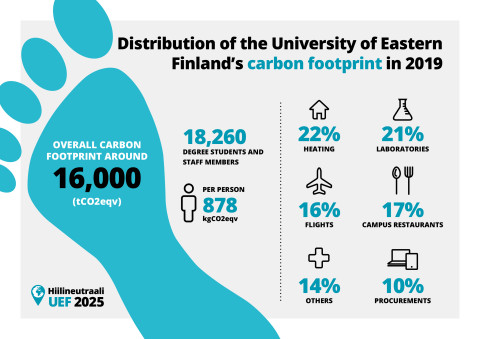Becoming carbon neutral by the end of 2025 is a strategic goal for the University of Eastern Finland. Achieving this goal calls for a change in the way we do things, as well as carbon offsetting.
The year 2020 witnessed an analysis of carbon emissions originating from the university's facilities, procurements, travel, campus restaurants, and laboratories. The overall carbon footprint of the University of Eastern Finland amounts to around 16,000 metric tons of carbon dioxide equivalents (tCO2eqv). The carbon footprint is typically expressed as carbon dioxide equivalents, which besides emissions of carbon dioxide also consider other greenhouse gas emissions.
“We have compared our results against those of the University of Turku, and our distribution of emissions is very similar to theirs. Facilities are the main source of emissions, followed by travel and laboratories,” Coordinator Maiju Eskelinen from the Carbon Neutral UEF 2025 project says.
The University of Turku was the first Finnish university to calculate its carbon footprint. In addition to the University of Eastern Finland, many other Finnish universities are also in the process of calculating their carbon footprint, which means that results can be compared more extensively in 2021. However, making comparisons isn’t that straightforward.
“We were surprised by the multitude of calculation methods. Moreover, there isn’t a single standard to follow and the categories used in the calculations aren’t unambiguous. For instance, our emissions from procurements were greater than those of the University of Turku, but that’s because we have more procurement categories. On the other hand, our carbon footprint per person is 878 kilograms, whereas the University of Turku’s is 1,100 kilograms, despite us having more variables in the calculation.
The carbon footprint per person was calculated by dividing the university’s emissions by the total number of its degree students and staff members.

Finding solutions in expert groups
The work was carried out in six groups, each focusing respectively on facilities, procurements, travel, campus restaurants, laboratories, and science communication. Researchers and experts in the respective fields contributed to the work, and the university’s Facilities Management and Financial Services also made their expertise available. In addition to calculating the carbon footprints, the groups also brainstormed for ideas on how to reduce emissions.
“In the group focusing on travel, we had Professor in Applied Statistics Lauri Mehtätalo as a member, and his expertise allowed us to assess the emissions of travel with the help of statistical methods. Researchers from the Department of Applied Physics and the Department of Geographical and Historical Studies, among others, also participated in the groups. Each of their research and work is somehow connected to sustainable development, and without their contribution, we wouldn’t have achieved as good results or had as diverse discussions as we did,” Eskelinen says.
Partner representatives from University Properties of Finland Ltd., Compass Group, and Hansel also participated in the work, bringing to the table plenty of knowledge and practical know-how.
Students also play an important role in the project and in achieving its goal, and, to that end, representatives of the Student Union of the University of Eastern Finland also participated in the work.
“Our goal was to raise awareness of these things among students and to inspire them to become involved in carbon neutrality work through, for example, their personal choices,” Eskelinen says.
The calculations have now been made, but the work continues.
“This is where the concrete work begins, as we start putting things to practice. We will be proposing measures relating to travel and to the promotion of meat-free days in our campus restaurants.”
The entire academic community will have an opportunity comment on these measures before they get confirmed.
Carbon offsetting is not a ‘Get Out of Jail Free Card’ that justifies emissions. Preventing and reducing emissions is always more important, and offsetting should be used as a last resort.
Maiju Eskelinen
Coordinator
Measures to reach the goal
Flying is the main source of travel-related emissions, and it is also a major component in the overall carbon footprint. The coronavirus pandemic has caused a natural decline in flying, and there is no going back to how things were. The measures include a proposal of new travel guidelines which highlight consideration of how necessary the planned trip is. In addition, travel agencies should provide information about the carbon footprint of different travel alternatives, and also offer low-carbon routes.
“The idea is not to ban travel altogether, but we should pay closer attention to whether the pros outweigh the cons. The coronavirus pandemic has shown that many meetings and conferences can be held online. Of course, physically attending events and meeting people in more unofficial settings are vital for forging important contacts and exchanging ideas. I believe that the future of events will be hybrid, allowing participation both online and on site,” Eskelinen says.

The goal is ambitious, but attainable
Already now, the University of Eastern Finland offsets carbon emissions of flying, among other things. In practice, this means that the price set for a metric ton of carbon dioxide is paid to a carbon offsetting service to match the real emissions. Carbon offsetting services, on the other hand, provide funding for measures that reduce emissions, such as various projects that promote the use of renewable energy. The problem with these services is that there is variation in their quality and an absence of regulation.
“Although carbon offsetting has its positive sides, one must remain critical. Because there is no regulation, different services use different criteria to define the price of a metric ton of CO2, sometimes resulting in great differences,” Eskelinen says.
However, carbon offsetting is needed also in the future because there will still be emissions in 2025.
“Carbon offsetting is not a ‘Get Out of Jail Free Card’ that justifies emissions. Preventing and reducing emissions is always more important, and offsetting should be used as a last resort.”
According to Eskelinen, the university’s goal of becoming carbon neutral by 2025 is ambitious, but attainable through determined efforts.
“Projections show that emissions originating from facilities will reduce even without any measures taken by the university. Of course, we will strive to improve energy efficiency in connection with our renovation projects, but the greatest reductions in emissions will come from the development of energy companies.”
The reduction of the carbon footprint can also be enhanced by increasing the carbon handprint. A positive carbon handprint can be achieved by using a solution that reduces the carbon footprint of another solution. For instance, the carbon handprint could be used to describe the positive effects of research in cases where said research promotes carbon neutrality. However, the carbon handprint cannot be measured as such.
“We want to be extremely transparent in our work, because the idea is not to appear more responsible than we actually are. That would be greenwashing – something we want to avoid.”

